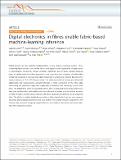| dc.contributor.author | Loke, Gabriel | |
| dc.contributor.author | Khudiyev, Tural | |
| dc.contributor.author | Wang, Brian | |
| dc.contributor.author | Fu, Stephanie | |
| dc.contributor.author | Payra, Syamantak | |
| dc.contributor.author | Shaoul, Yorai | |
| dc.contributor.author | Fung, Johnny | |
| dc.contributor.author | Chatziveroglou, Ioannis | |
| dc.contributor.author | Chou, Pin-Wen | |
| dc.contributor.author | Chinn, Itamar | |
| dc.contributor.author | Yan, Wei | |
| dc.contributor.author | Gitelson-Kahn, Anna | |
| dc.contributor.author | Joannopoulos, John | |
| dc.contributor.author | Fink, Yoel | |
| dc.date.accessioned | 2022-04-27T16:11:41Z | |
| dc.date.available | 2022-04-27T16:11:41Z | |
| dc.date.issued | 2021 | |
| dc.identifier.uri | https://hdl.handle.net/1721.1/142136 | |
| dc.description.abstract | <jats:title>Abstract</jats:title><jats:p>Digital devices are the essential building blocks of any modern electronic system. Fibres containing digital devices could enable fabrics with digital system capabilities for applications in physiological monitoring, human-computer interfaces, and on-body machine-learning. Here, a scalable preform-to-fibre approach is used to produce tens of metres of flexible fibre containing hundreds of interspersed, digital temperature sensors and memory devices with a memory density of ~7.6 × 10<jats:sup>5</jats:sup> bits per metre. The entire ensemble of devices are individually addressable and independently operated through a single connection at the fibre edge, overcoming the perennial single-fibre single-device limitation and increasing system reliability. The digital fibre, when incorporated within a shirt, collects and stores body temperature data over multiple days, and enables real-time inference of wearer activity with an accuracy of 96% through a trained neural network with 1650 neuronal connections stored within the fibre. The ability to realise digital devices within a fibre strand which can not only measure and store physiological parameters, but also harbour the neural networks required to infer sensory data, presents intriguing opportunities for worn fabrics that sense, memorise, learn, and infer situational context.</jats:p> | en_US |
| dc.language.iso | en | |
| dc.publisher | Springer Science and Business Media LLC | en_US |
| dc.relation.isversionof | 10.1038/S41467-021-23628-5 | en_US |
| dc.rights | Creative Commons Attribution 4.0 International license | en_US |
| dc.rights.uri | https://creativecommons.org/licenses/by/4.0/ | en_US |
| dc.source | Nature | en_US |
| dc.title | Digital electronics in fibres enable fabric-based machine-learning inference | en_US |
| dc.type | Article | en_US |
| dc.identifier.citation | Loke, Gabriel, Khudiyev, Tural, Wang, Brian, Fu, Stephanie, Payra, Syamantak et al. 2021. "Digital electronics in fibres enable fabric-based machine-learning inference." Nature Communications, 12 (1). | |
| dc.contributor.department | Massachusetts Institute of Technology. Department of Materials Science and Engineering | |
| dc.contributor.department | Massachusetts Institute of Technology. Research Laboratory of Electronics | |
| dc.contributor.department | Massachusetts Institute of Technology. Department of Electrical Engineering and Computer Science | |
| dc.contributor.department | Massachusetts Institute of Technology. Department of Mechanical Engineering | |
| dc.contributor.department | Massachusetts Institute of Technology. Institute for Soldier Nanotechnologies | |
| dc.contributor.department | Massachusetts Institute of Technology. Department of Physics | |
| dc.relation.journal | Nature Communications | en_US |
| dc.eprint.version | Final published version | en_US |
| dc.type.uri | http://purl.org/eprint/type/JournalArticle | en_US |
| eprint.status | http://purl.org/eprint/status/PeerReviewed | en_US |
| dc.date.updated | 2022-04-27T16:01:16Z | |
| dspace.orderedauthors | Loke, G; Khudiyev, T; Wang, B; Fu, S; Payra, S; Shaoul, Y; Fung, J; Chatziveroglou, I; Chou, P-W; Chinn, I; Yan, W; Gitelson-Kahn, A; Joannopoulos, J; Fink, Y | en_US |
| dspace.date.submission | 2022-04-27T16:01:20Z | |
| mit.journal.volume | 12 | en_US |
| mit.journal.issue | 1 | en_US |
| mit.license | PUBLISHER_CC | |
| mit.metadata.status | Authority Work and Publication Information Needed | en_US |
